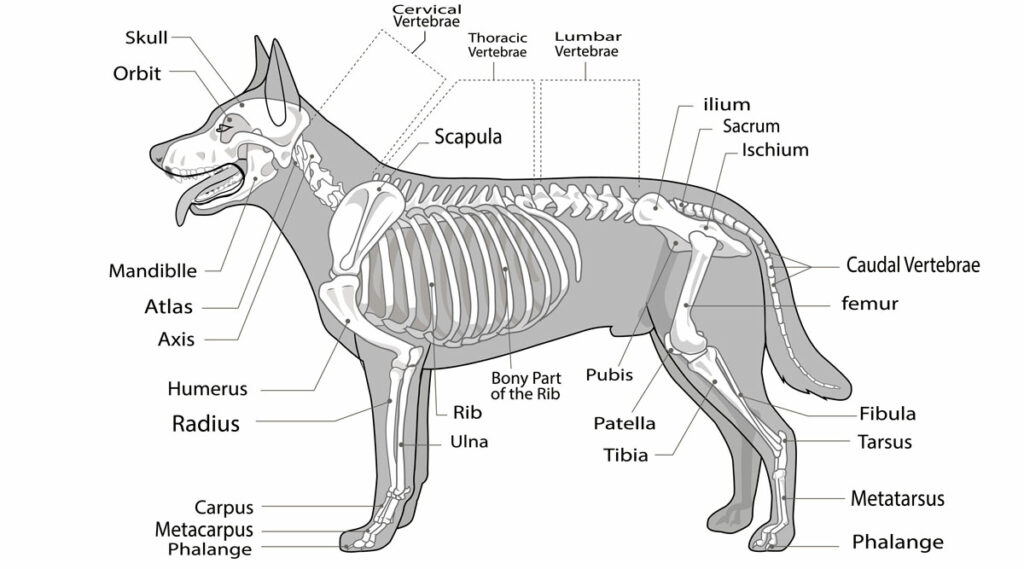Dogs certainly do have bones in their tails. In fact, the average dog tail contains around 20 vertebrae, although the exact amount varies a lot depending on the dog breed and length of the tail.
In this article, we’ll discuss dog tail anatomy in more detail. We’ll also briefly look at tail fractures and how to identify them.
Contents
Do Dogs Have Bones in Their Tails?
Contrary to common belief, a dog’s tail isn’t just muscle—it’s an extension of the spine that contains multiple bones.
These bones are known as caudal vertebrae. The number of caudal vertebrae in a dog’s tail varies between 5-23 depending on breed, but the average number is about 20.
The shape of the caudal vertebrae bones also depends on the type of tail. Some tails, including tightly wound curled tails, have wedge-shaped vertebrae. Other tails contain more cylindrical caudal bones.
Regardless of the shape, the bones typically get smaller as you move towards the end of the tail. This is why many dog tails have a taper.
Why Are There Bones in a Dog Tail?
Even though dog tails seem soft and fluid, they need bones for structure and support. Without bones, a dog’s tail would be too soft. It certainly wouldn’t be capable of the fine, nuanced movements we associate with tail wagging.
Besides providing structure, bones also serve as attachment points for the muscles. If there were no bones in the tail, dogs wouldn’t be able to wag, as the muscles wouldn’t have anything to pull against.
Anatomy of a Dog’s Tail

As we’ve already discussed, a dog’s tail contains anywhere from 5-23 caudal vertebrae that are essentially an extension of the spine. These bones connect with each other via ligaments and are separated by cartilage pads, which prevent the bones from rubbing against each other.
The tail’s movement is controlled by muscles that attach to the vertebrae via tendons. Dogs have some conscious control over these muscles, but most tail movements happen instinctively due to the dog’s movement or emotions.
Tails are also rich in nerves, some of which are associated with controlling the bowels. As a result, tail injuries can sometimes cause bowel issues.
The bones, ligaments, and muscles of the tail are surrounded by connective tissue. The whole tail is then covered by skin, and in most dogs, topped with a layer of hair.
Tail Bone Fractures in Dogs
The vertebrae in a tail are more exposed than many other bones in a dog’s body. For this reason, fractures in the tail vertebrae are relatively common.
Potential symptoms of a tail fracture in dogs include:
- Swelling
- Change in tail position or wagging patterns
- Difficulty walking
- A lump or bump in the tail
- Whining or crying
- Tail guarding
The severity of a tail fracture depends on how badly the bone is damaged, but also on where the fracture occurred.
A fracture at the tail’s base can be very severe, as this location also contains important nerves and blood vessels. This type of fracture can even cause bowel issues and incontinence due to nerve damage.
Fractures at the tail’s tip, although painful, typically have fewer complications and are more likely to heal on their own.
Regardless of the location, any suspected tail fracture should be treated as an emergency and assessed by a vet.
Even minor fractures can cause intense pain, so your dog may need medication for symptom management. More severe fractures might need extra treatment or even amputation. Your vet will likely conduct a physical exam and possibly an X-ray to understand the fracture’s location and severity.
Vet Note From Dr Linda Simon: “Some breeds, such as the Bulldog, Boston Terrier, Pug and Frenchie, are more likely to be born with a congenital kink in their tail. This is not due to a fracture or trauma, but can be indicative of the dog having hemivertebra higher up in their spinal cord.”
Why Are Tails Important to Dogs?
Dog tails serve three main purposes: communication, balance, and swimming. Let’s take a closer look at each in more detail.
- Communication. Dogs use their tails as a communication tool with humans and other dogs. This tail language is far more nuanced than you might think—a wagging tail doesn’t always signify a happy dog. A stiff tail can mean alertness, while a tail tucked between the legs can show anxiety. To understand more, check out our guides on why dogs wag their tails and dog tail meanings.
- Balance. Dog tails are important for balance, particularly during direction changes. Watch how a dog’s tail moves in the opposite direction when they’re turning—it acts as a counterweight.
- Swimming. Like a boat’s rudder, a tail helps steer dogs when swimming. That’s why strong swimming breeds, like Labrador retrievers, have thick “otter” tails. To learn more, read our guide to dog tail types.
And let’s not forget warmth. Some breeds with bushy tails, like the Siberian husky, use their tails to keep warm by covering their noses.
Can Dogs Feel Pain in Their Tail?
Yes, dogs can feel pain in their tails just like any other body part.
Tails are rich in nerve endings and pain receptors that send signals to the brain. This means dogs can feel pain as a result of sudden tail injuries, like getting caught in a door or being stepped on. Pain in a tail can also be caused by medical conditions, such as skin allergies or parasites.
“Some dogs try to cope with tail pain by compulsively licking,” says vet Dr Linda Simon. “We want to avoid this to prevent skin damage, and I’d generally advise using a buster collar to do so.”
On a related note, The Dog Clinic is firmly against tail docking. This extremely painful procedure, often performed without anesthetic on young puppies, can cause severe nerve damage, chronic pain, and deprives dogs of a vital communication tool. We’re heartened to see that tail docking is becoming illegal in many places worldwide.
Summary
Dog tails contain anywhere from 5 to 23 caudal vertebrae bones. The structure provided by the caudal vertebrae allows the tail to serve key roles in balance, swimming, and most importantly, communication.
Unfortunately, the tail’s exposed position makes them prone to fractures and other injuries. If you notice any changes to your dog’s tail position or wagging, contact a vet immediately.
Do you have any questions about whether dog tails contain bones? Please let us know in the comments section.




